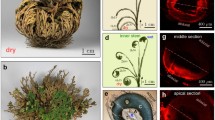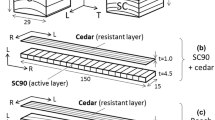Abstract
It is of great significance to study the water absorption and expansion of cells, which are essential for the growth and life regulation of plants, not only for understanding the complex life phenomena of plants, but also for the manufacture of biomimetic materials. The main purpose of this study is to shed light on the mechanism of a novel coiling phenomenon of the split dandelion scape soaked in water and the high concentration mannitol solution. We discovered that the difference between water absorption/dehydration capacities of inner cells and lateral cells of the split dandelion scape generates asymmetric expansion/contraction between inner and lateral layers, resulting two opposite coiled patterns. Analogous to the deformable hypothesis of the thermal expansion model, the water absorption-induced cell expansion model was proposed to explain the coiling process of the split dandelion scape. Both the simulation and experimental results revealed that the coiling of dandelion scape is strongly depended on the response of cells to the stimulation of the solution environment. Showing considerable potential load bearing capacity of plants, the coiling phenomenon can be an inspiration to the designs of soft robots and bionic sensors for humidity control.







Similar content being viewed by others
References
Burgert I , Fratzl P . Actuation systems in plants as prototypes for bioinspired devices[J]. Philosophical Transactions of the Royal Society A: Mathematical, Physical and Engineering Sciences, 2009. https://doi.org/10.1098/rsta.2009.0003.
Forterre Y, Skotheim JM, Dumais J, Mahadevan L. How the Venus flytrap snaps. Nature. 2005;433(7024):421–5. https://doi.org/10.1038/nature03185.
Braam J. In touch: Plant responses to mechanical stimuli. New Phytol. 2005;165(2):373–89. https://doi.org/10.1111/j.1469-8137.2004.01263.x.
Volkov AG, Adesina T, Markin VS, Jovanov E. Kinetics and Mechanism of Dionaea muscipula. Trap Closing Plant Physiol. 2008;146(2):694–702. https://doi.org/10.1104/pp.107.108241.
Ismarrubie ZN, Goh HL, Masuri S, Yussof H. Bio-mechanism response of mimosa pudica against external stimulation. Adv Mater Res. 2015;1125:588–92.
Kagawa H, Saito E. A model on the main pulvinus movement of mimosa pudica. JSME Int J Series C. 2000;43(4):923–8. https://doi.org/10.1299/jsmec.43.923.
Reyssat E, Mahadevan L. Hygromorphs: From pine cones to biomimetic bilayers. J Royal Soc Interface. 2009;6(39):951–7. https://doi.org/10.1098/rsif.2009.0184.
Dawson C, Vincent JFV, Rocca A-M. How pine cones open. Nature. 1997;390(6661):668.
Coutand C, Fournier M, Moulia B. The gravitropic response of poplar trunks: Key roles of prestressed wood regulation and the relative kinetics of cambial growth versus wood maturation. Plant Physiol. 2007;144(2):1166–80. https://doi.org/10.1104/pp.106.088153.
Hill BS, Findlay GP. The power of movement in plants: The role of osmotic machines. Quart Rev Biophys. 1981;14(2):173–222. https://doi.org/10.1017/S0033583500002249.
Toriyama H, Jaffe MJ. Migration of calcium and its role in the regulation of seismonasty in the motor cell of mimosa pudica L. Plant Physiol. 1972;49(1):72–81. https://doi.org/10.1104/pp.49.1.72.
Uehlein N, Kaldenhoff R. Aquaporins and plant leaf movements. Ann Botany. 2007;101(1):1–4. https://doi.org/10.1093/aob/mcm278.
Elbaum R, Zaltzman L, Burgert I, Fratzl P. The role of wheat awns in the seed dispersal unit. Science. 2007;316(5826):884–6. https://doi.org/10.1126/science.1140097.
Abraham Y, Tamburu C, Klein E, Dunlop JWC, Fratzl P, Raviv U, et al. Tilted cellulose arrangement as a novel mechanism for hygroscopic coiling in the stork’s bill awn. J Royal Soc Interface. 2012;9(69):640–7. https://doi.org/10.1098/rsif.2011.0395.
Proseus TE, Zhu GL, Boyer JS. Turgor, temperature and the growth of plant cells: using Chara corallina as a model system. J Exp Botany. 2000;51(350):1481–94. https://doi.org/10.1093/jexbot/51.350.1481.
Lee S, Zargar O, Reiser C, Li Q, Muliana A, Finlayson SA, et al. Time-dependent mechanical behavior of sweet sorghum stems. J Mech Behav Biomed Mater. 2020;106:103731. https://doi.org/10.1016/j.jmbbm.2020.103731.
Ha NS, Lu G, Shu D, Yu TX. Mechanical properties and energy absorption characteristics of tropical fruit durian (Durio zibethinus). J Mech Behav Biomed Mater. 2020;104:103603. https://doi.org/10.1016/j.jmbbm.2019.103603.
Pieranski P, Baranska J, Skjeltorp A. Tendril perversion-a physical implication of the topological conservation law. Europ J Phys. 2004;25(5):613–21. https://doi.org/10.1088/0143-0807/25/5/004.
Wang J-S, Wang G, Feng X-Q, Kitamura T, Kang Y-L, Yu S-W, et al. Hierarchical chirality transfer in the growth of Towel Gourd tendrils. Sci Rep. 2013;3(1):3102. https://doi.org/10.1038/srep03102.
Gerbode SJ, Puzey JR, McCormick AG, Mahadevan L. How the Cucumber Tendril Coils and Overwinds. Science. 2012;337(6098):1087–91. https://doi.org/10.1126/science.1223304.
Wu W, Geng L, Niu Y, Qi D, Cui X, Fang D. Compression twist deformation of novel tetrachiral architected cylindrical tube inspired by towel gourd tendrils. Extreme Mech Lett. 2018;20:104–11. https://doi.org/10.1016/j.eml.2018.02.001.
Fratzl P, Elbaum R, Burgert I. Cellulose fibrils direct plant organ movements. Faraday Disc. 2008;139:275–82. https://doi.org/10.1039/B716663J.
Skotheim JM, Mahadevan L. Physical limits and design principles for plant and fungal movements. Science. 2005;308(5726):1308–10. https://doi.org/10.1126/science.1107976.
Dumais J, Forterre Y. Vegetable Dynamicks: The role of water in plant movements. Annual Rev Fluid Mech. 2012;44(1):453–78. https://doi.org/10.1146/annurev-fluid-120710-101200.
Oey ML, Vanstreels E, De Baerdemaeker J, Tijskens E, Ramon H, Hertog MLATM et al. Effect of turgor on micromechanical and structural properties of apple tissue: A quantitative analysis. Postharvest Biology and Technology. 2007;44(3):240-7. https://doi.org/10.1016/j.postharvbio.2006.12.015
Wang L-L, Chen A-P, Zhong N-Q, Liu N, Wu X-M, Wang F, et al. The Thellungiella salsuginea Tonoplast Aquaporin TsTIP1;2 Functions in Protection Against Multiple Abiotic Stresses. Plant Cell Physiol. 2013;55(1):148–61. https://doi.org/10.1093/pcp/pct166.
Kuang Y, Chen C, Cheng J, Pastel G, Li T, Song J, et al. Selectively aligned cellulose nanofibers towards high-performance soft actuators. Extreme Mech Lett. 2019;29:100463. https://doi.org/10.1016/j.eml.2019.100463.
Liu D, Tarakanova A, Hsu CC, Yu M, Zheng S, Yu L, et al. Spider dragline silk as torsional actuator driven by humidity. Science Advances. 2019;5(3):eaau9183. https://doi.org/10.1126/sciadv.aau9183.
Chen Z, Liang X, Wu T, Yin T, Xiang Y, Qu S. Pneumatically actuated soft robotic arm for adaptable grasping. Acta Mechanica Solida Sinica. 2018;31(5):608–22. https://doi.org/10.1007/s10338-018-0052-4.
Acknowledgements
The authors greatly appreciate the financial support of the National Natural Science Foundation of China (11502155), Natural Science Foundation of Shanxi Province (201901D211112) and the Scientific and Technological Innovation Programs of Higher Education Institutions in Shanxi (2019L0328). We thank Prof. Yuren Wang and Mrs. Tingting Zhao for discussions.
Author information
Authors and Affiliations
Corresponding author
Rights and permissions
About this article
Cite this article
Zhang, C., Qiao, T., Zhou, K. et al. The Coiling of Split Dandelion Scape Induced by Cell Hygroscopicity. Acta Mech. Solida Sin. 34, 393–403 (2021). https://doi.org/10.1007/s10338-021-00227-x
Received:
Revised:
Accepted:
Published:
Issue Date:
DOI: https://doi.org/10.1007/s10338-021-00227-x




